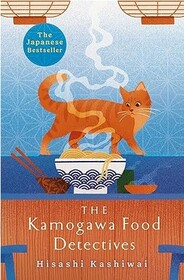Nope, not a fan.
While the translator clearly tried to introduce the reader to Japanese culture, to the point of being actually very irritating, I can't imagine how anyone unfamiliar with Japanese food and place names could possibly make heads or tails of this story. I was extremely bored and couldn't even visualize the heavily described dishes because, other than the random beef stew and spaghetti, they were all unfamiliar ingredients to me. There were too many unfamiliar foods described without actual explanation for me to get that part of the concept. It was hard to imagine because I don't know what they are or they're unclean meats I wouldn't eat, so it was a big turn off. Clearly I'm not the intended audience. Haha!
It was definitely written (poorly, I do add) as a Japanese 101 which leads me to believe this is a book inspired by the original and not a direct translation. Besides the encyclopedic interjections, ad nauseum, there were too many inserted Western phrases like, âcountry bumpkinâ.
Here's an example from pg 174 showing how the reader really needs to be familiar with Japan to get what's going on:
Hisahiko: "'Incredible flavour. I'm guessing the fish is from the Inland Sea.'
Tae: 'The Uwa Bay, I believe.'
Hisahiko: 'I see. No wonder it tastes so good.'"
No explanation of why any of this is. They just know and we are just supposed to know. BUT, no one is gonna understand this without explanation! I regularly felt like I'd been eavesdropping on a couple of people locked in a name dropping competition.
I found the character of Koishi to be rude and argumentative and the rest of the characters to be unnecessary. Zero personalities on any of them. Meh.
While the translator clearly tried to introduce the reader to Japanese culture, to the point of being actually very irritating, I can't imagine how anyone unfamiliar with Japanese food and place names could possibly make heads or tails of this story. I was extremely bored and couldn't even visualize the heavily described dishes because, other than the random beef stew and spaghetti, they were all unfamiliar ingredients to me. There were too many unfamiliar foods described without actual explanation for me to get that part of the concept. It was hard to imagine because I don't know what they are or they're unclean meats I wouldn't eat, so it was a big turn off. Clearly I'm not the intended audience. Haha!
It was definitely written (poorly, I do add) as a Japanese 101 which leads me to believe this is a book inspired by the original and not a direct translation. Besides the encyclopedic interjections, ad nauseum, there were too many inserted Western phrases like, âcountry bumpkinâ.
Here's an example from pg 174 showing how the reader really needs to be familiar with Japan to get what's going on:
Hisahiko: "'Incredible flavour. I'm guessing the fish is from the Inland Sea.'
Tae: 'The Uwa Bay, I believe.'
Hisahiko: 'I see. No wonder it tastes so good.'"
No explanation of why any of this is. They just know and we are just supposed to know. BUT, no one is gonna understand this without explanation! I regularly felt like I'd been eavesdropping on a couple of people locked in a name dropping competition.
I found the character of Koishi to be rude and argumentative and the rest of the characters to be unnecessary. Zero personalities on any of them. Meh.
How many times in our lives does food connect to memories? The simple act of eating certain dishes connects to memories of family, etc. In this book set in Japan, the Kamogawa Food Detectives take clients memories associated with specific dishes from their memories and recreate them. Often times, it reveals interesting revelations to their clients.




